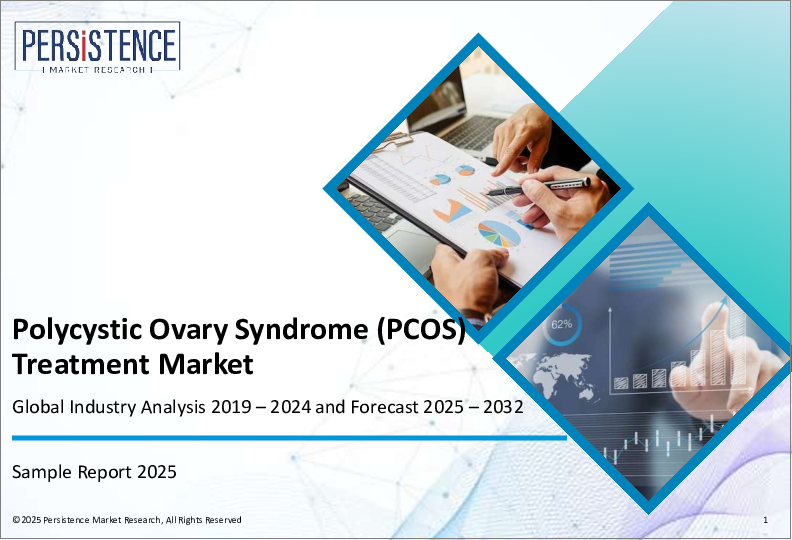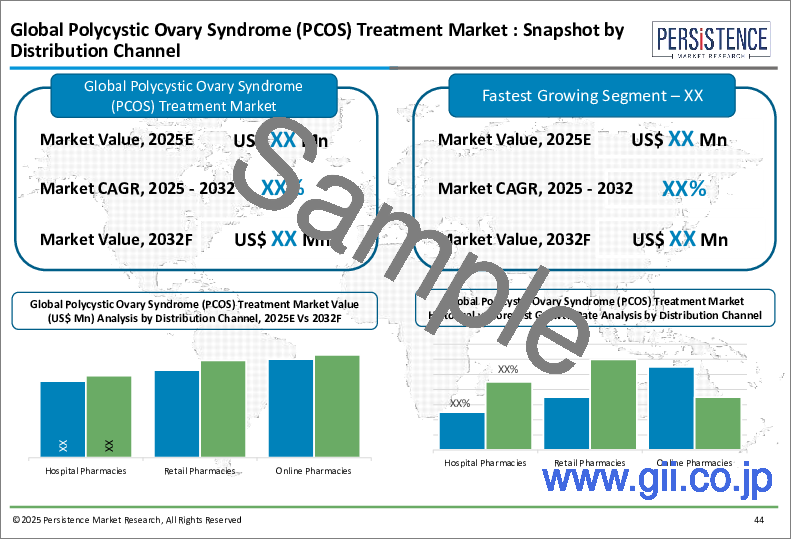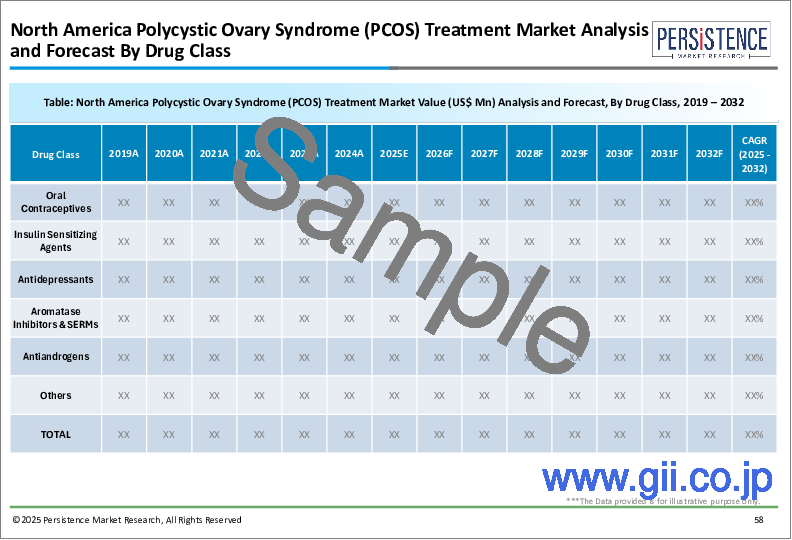|
|
市場調査レポート
商品コード
1731531
多嚢胞性卵巣症候群(PCOS)治療の世界市場:産業分析、規模、シェア、成長、動向、予測、2025年~2032年Polycystic Ovary Syndrome (PCOS) Treatment Market: Global Industry Analysis, Size, Share, Growth, Trends, and Forecast, 2025 - 2032 |
||||||
カスタマイズ可能
|
|||||||
| 多嚢胞性卵巣症候群(PCOS)治療の世界市場:産業分析、規模、シェア、成長、動向、予測、2025年~2032年 |
|
出版日: 2025年05月22日
発行: Persistence Market Research
ページ情報: 英文 198 Pages
納期: 2~5営業日
|
全表示
- 概要
- 目次
Persistence Market Researchはこのほど、多嚢胞性卵巣症候群(PCOS)治療の世界市場に関する包括的なレポートを発表しました。当レポートでは、市場促進要因・動向・機会・課題など、重要な市場力学を徹底的に評価し、市場構造に関する詳細な洞察を提供しています。この調査レポートは、2025年~2032年の世界のPCOS治療市場の予測成長軌道を概説する独占データと統計を掲載しています。
主な洞察
- PCOS治療市場規模(2025年):45億米ドル
- 予測市場価値(2032年):62億米ドル
- 世界市場成長率(CAGR 2025年~2032年):4.7%
PCOS治療市場 - レポート範囲:
多嚢胞性卵巣症候群(PCOS)は、生殖年齢の女性に影響を及ぼす最も一般的なホルモン疾患の1つです。PCOS治療市場には、この疾患の症状を管理するための薬剤、生活習慣管理ソリューション、医療機器が含まれます。これらの治療は、月経不順、不妊症、にきび、多毛症などの症状に対処することを目的としています。PCOS治療市場は、経口避妊薬、抗アンドロゲン薬、インスリン感作薬などの医薬品治療を提供し、病院、クリニック、在宅ケア環境など、さまざまなヘルスケア環境にサービスを提供しています。市場は、PCOSに対する認識の高まり、有病率の増加、患者の転帰を改善する治療オプションの進歩によって活性化されています。
市場促進要因:
世界のPCOS治療市場は、ライフスタイルの変化、不健康な食生活、環境要因によるPCOSの罹患率の上昇など、いくつかの重要な要因によって推進されています。PCOSとその女性の健康への影響に関する治療意識の高まりは、効果的な治療オプションに対する需要の高まりにつながっています。さらに、不妊治療やホルモンバランスの乱れを調整する薬剤の進歩が、市場の拡大に寄与しています。また、早期診断・早期治療を求める女性の動向も市場需要を押し上げています。さらに、不妊治療クリニックや内分泌専門医の数が世界的に増加していることも、PCOS治療へのアクセスを高めています。
市場抑制要因:
PCOS治療市場は、有望な成長の見込みがあるにもかかわらず、特に新興国において、治療や薬剤の高コストに関する課題に直面しています。PCOS治療に対する償還範囲が限定的であることや、特定地域における認知度の低さが、さらに市場成長を制約しています。さらに、いくつかの治療法の副作用やPCOSの決定的な治療法がないことが、患者が長期的な治療計画を守ることを躊躇させる可能性があります。また、治療効果は個人によって大きく異なるため、個別ケアの提供という課題もあります。
市場機会:
PCOS治療市場は、新薬製剤、ホルモン療法、低侵襲外科処置の開発などの技術革新によって大きな成長機会をもたらしています。PCOSの症状を管理するための遠隔医療やモバイル健康アプリケーションの人気の高まりは、市場企業に新たな道を提供します。さらに、個別の治療計画に焦点を当てた個別化医療の動向の高まりは、PCOS患者の特定のニーズによりよく対応するオーダーメイドのソリューションを生み出すと予想されます。また、不妊治療クリニック、ヘルスケア提供者、保険会社との連携による償還オプションの改善も、経済的障壁の克服に役立つ可能性があります。
本レポートで扱う主な質問
- PCOS治療市場の世界的成長を促進する主な要因は何か?
- PCOSの管理において最も広く採用されている治療オプションは何か、またそれらはどのように進化しているか?
- 技術の進歩はPCOSの新規治療開発にどのような影響を与えているか?
- PCOS治療市場の主要企業はどこで、市場の関連性を維持するためにどのような戦略をとっているのか?
- 世界のPCOS治療市場における新たな動向と将来展望は?
目次
第1章 エグゼクティブサマリー
第2章 市場概要
- 市場の範囲と定義
- 市場力学
- 促進要因
- 抑制要因
- 機会
- 主な動向
- マクロ経済要因
- 世界のセクター別展望
- 世界GDP成長見通し
- COVID-19の影響分析
- 予測要因:関連性と影響
第3章 付加価値のある洞察
- 製品採用分析
- 疾病疫学
- 規制状況
- ポーターのファイブフォース分析
- PESTLE分析
- 主要企業によるプロモーション戦略
第4章 世界の多嚢胞性卵巣症候群(PCOS)治療市場の展望
- 主なハイライト
- 市場規模と前年比成長率
- 絶対的収益機会
- 市場規模の分析と予測
- 過去の市場規模分析、2019年~2024年
- 市場規模分析と予測、2025~2032年
- 世界の多嚢胞性卵巣症候群(PCOS)治療市場の展望:薬剤クラス別
- イントロダクション/主な調査結果
- 過去の市場規模分析:薬剤クラス別(2019年~2024年)
- 市場規模分析・予測:薬剤クラス別(2025年~2032年)
- 経口避妊薬
- インスリン抵抗性改善薬
- 抗うつ薬
- 抗アンドロゲン
- アロマターゼ阻害剤とSERM
- その他
- 市場の魅力分析:薬剤クラス別
- 世界の多嚢胞性卵巣症候群(PCOS)治療市場の展望:流通チャネル別
- イントロダクション/主な調査結果
- 過去の市場規模分析:流通チャネル別(2019年~2024年)
- 市場規模分析・予測:流通チャネル別(2025年~2032年)
- 院内薬局
- 小売薬局
- オンライン薬局
- 市場の魅力分析:流通チャネル別
第5章 世界の多嚢胞性卵巣症候群(PCOS)治療市場の展望:地域別
- 主なハイライト
- 過去の市場規模分析:地域別(2019年~2024年)
- 市場規模分析・予測:地域別(2025年~2032年)
- 北米
- 欧州
- 東アジア
- 南アジア・オセアニア
- ラテンアメリカ
- 中東・アフリカ
- 市場の魅力分析:地域
第6章 北米の多嚢胞性卵巣症候群(PCOS)治療市場の展望
第7章 欧州の多嚢胞性卵巣症候群(PCOS)治療市場の展望
第8章 東アジアの多嚢胞性卵巣症候群(PCOS)治療市場の展望
第9章 南アジア・オセアニアの多嚢胞性卵巣症候群(PCOS)治療市場の展望
第10章 ラテンアメリカの多嚢胞性卵巣症候群(PCOS)治療市場の展望
第11章 中東・アフリカの多嚢胞性卵巣症候群(PCOS)治療市場の展望
第12章 競合情勢
- 市場シェア分析、2025年
- 市場構造
- 競合激化マップ:市場別
- 競合ダッシュボード
- 企業プロファイル(詳細:概要、財務、戦略、最近の動向)
- Perrigo Company plc
- Teva Pharmaceuticals USA, Inc.
- Mylan NV(Viatris Inc.)
- Lupin
- Astellas Pharma Inc.
- Pfizer Inc.
- Johnson &Johnson Services, Inc.
- Glenmark Pharmaceuticals Limited
- Takeda Pharmaceutical Company Limited
- Organon
- Marksans Pharma Ltd.
- DDII BIOTECH PRIVATE LIMITED
- Arlak Biotech
- ADVANZ PHARMA
- ANI Pharmaceuticals, Inc.
- Insud Pharma
- Gedeon Richter Plc.
- Breckenridge Pharmaceutical, Inc.
- Suvida
- DKT INTERNATIONAL
- Aurobindo Pharma Limited
- Avion Pharmaceuticals, LLC
第13章 付録
- 調査手法
- 調査の前提条件
- 頭字語と略語
Persistence Market Research has recently released a comprehensive report on the worldwide market for Polycystic Ovary Syndrome (PCOS) treatments. The report offers a thorough assessment of crucial market dynamics, including drivers, trends, opportunities, and challenges, providing detailed insights into the market structure. This research publication presents exclusive data and statistics outlining the anticipated growth trajectory of the global PCOS treatment market from 2025 to 2032.
Key Insights:
- PCOS Treatment Market Size (2025E): USD 4.5 Billion
- Projected Market Value (2032F): USD 6.2 Billion
- Global Market Growth Rate (CAGR 2025 to 2032): 4.7%
PCOS Treatment Market - Report Scope:
Polycystic Ovary Syndrome (PCOS) is one of the most common hormonal disorders affecting women of reproductive age. The market for PCOS treatments includes medications, lifestyle management solutions, and medical devices to help manage the symptoms of the disorder. These treatments aim to address symptoms like irregular menstruation, infertility, acne, and hirsutism. The PCOS treatment market serves various healthcare settings, including hospitals, clinics, and homecare environments, providing pharmaceutical treatments such as oral contraceptives, anti-androgens, insulin sensitizers, and other drugs. The market is fueled by rising awareness of PCOS, an increasing prevalence of the condition, and advancements in treatment options that offer enhanced patient outcomes.
Market Growth Drivers:
The global PCOS treatment market is propelled by several key factors, including the rising incidence of PCOS due to lifestyle changes, unhealthy diets, and environmental factors. Increasing awareness about PCOS and its impact on women's health has led to greater demand for effective treatment options. Furthermore, advancements in fertility treatments and medications that help regulate hormonal imbalances are contributing to the market's expansion. The growing trend of women seeking early diagnosis and treatment is also boosting market demand. Additionally, the increasing number of fertility clinics and endocrinology specialists worldwide is enhancing access to PCOS treatments.
Market Restraints:
Despite promising growth prospects, the PCOS treatment market faces challenges related to the high cost of treatments and medications, particularly in emerging economies. Limited reimbursement coverage for PCOS treatments and the lack of awareness in certain regions further constrain market growth. Additionally, the side effects of some treatments and the lack of a definitive cure for PCOS may deter patients from adhering to long-term treatment plans. The market also faces challenges in providing individualized care, as treatment effectiveness varies greatly from person to person.
Market Opportunities:
The PCOS treatment market presents significant growth opportunities driven by technological innovations, such as the development of new drug formulations, hormone therapies, and minimally invasive surgical procedures. The increasing popularity of telemedicine and mobile health applications for managing PCOS symptoms offers new avenues for market players. Moreover, the growing trend of personalized medicine, which focuses on individualized treatment plans, is expected to create tailored solutions that better address the specific needs of PCOS patients. Collaboration with fertility clinics, healthcare providers, and insurance companies to improve reimbursement options can also help overcome economic barriers.
Key Questions Answered in the Report:
- What are the primary factors driving the growth of the PCOS treatment market globally?
- Which treatment options are most widely adopted in the management of PCOS, and how are they evolving?
- How are technological advancements influencing the development of new treatments for PCOS?
- Who are the key players in the PCOS treatment market, and what strategies are they employing to maintain market relevance?
- What are the emerging trends and future prospects in the global PCOS treatment market?
Competitive Intelligence and Business Strategy:
Leading players in the global PCOS treatment market, including Bayer Healthcare, AbbVie, and Merck & Co., are focusing on innovation, product differentiation, and strategic partnerships to gain a competitive edge. These companies invest heavily in research and development to create advanced drug formulations and therapies, including combination therapies that address multiple symptoms of PCOS. Collaborations with healthcare providers, fertility clinics, and regulatory agencies help enhance market access and promote technology adoption. Additionally, emphasis on clinical trials and patient education fosters market growth and improves patient outcomes in the evolving PCOS treatment landscape.
Key Companies Profiled:
- Perrigo Company plc
- Teva Pharmaceuticals USA, Inc.
- Mylan N.V. (Viatris Inc.)
- Lupin
- Astellas Pharma Inc.
- Pfizer Inc.
- Johnson & Johnson Services, Inc.
- Glenmark Pharmaceuticals Limited
- Takeda Pharmaceutical Company Limited
- Organon
- Marksans Pharma Ltd.
- DDII BIOTECH PRIVATE LIMITED
- Arlak Biotech
- ADVANZ PHARMA
- ANI Pharmaceuticals, Inc.
- Insud Pharma
- Gedeon Richter Plc.
- Breckenridge Pharmaceutical, Inc.
- Suvida
- DKT INTERNATIONAL
- Aurobindo Pharma Limited
- Avion Pharmaceuticals, LLC
PCOS Treatment Market Research Segmentation:
The PCOS treatment market encompasses a diverse range of products, medications, and end-user segments, addressing various symptoms and patient needs.
By Drug Class:
- Oral Contraceptives
- Insulin Sensitizing Agents
- Antidepressants
- Aromatase Inhibitors & SERMs
- Antiandrogens
- Others
By Distribution Channel:
- Hospital Pharmacies
- Retail Pharmacies
- Online Pharmacies
By Region:
- North America
- Europe
- East Asia
- South Asia and Oceania
- Latin America
- Middle East & Africa
Table of Contents
1. Executive Summary
- 1.1. Global Polycystic Ovary Syndrome (PCOS) Treatment Market Snapshot, 2025-2032
- 1.2. Market Opportunity Assessment, 2025-2032, US$ Bn
- 1.3. Key Market Trends
- 1.4. Future Market Projections
- 1.5. Premium Market Insights
- 1.6. Industry Developments and Key Market Events
- 1.7. PMR Analysis and Recommendations
2. Market Overview
- 2.1. Market Scope and Definition
- 2.2. Market Dynamics
- 2.2.1. Drivers
- 2.2.2. Restraints
- 2.2.3. Opportunity
- 2.2.4. Key Trends
- 2.3. Macro-Economic Factors
- 2.3.1. Global Sectorial Outlook
- 2.3.2. Global GDP Growth Outlook
- 2.4. COVID-19 Impact Analysis
- 2.5. Forecast Factors - Relevance and Impact
3. Value Added Insights
- 3.1. Product Adoption Analysis
- 3.2. Disease Epidemiology
- 3.3. Regulatory Landscape
- 3.4. Porter's Five Forces Analysis
- 3.5. PESTLE Analysis
- 3.6. Promotional Strategies, By Key Players
4. Global Polycystic Ovary Syndrome (PCOS) Treatment Market Outlook
- 4.1. Key Highlights
- 4.1.1. Market Size (US$ Bn) and Y-o-Y Growth
- 4.1.2. Absolute $ Opportunity
- 4.2. Market Size (US$ Bn) Analysis and Forecast
- 4.2.1. Historical Market Size (US$ Bn) Analysis, 2019-2024
- 4.2.2. Market Size (US$ Bn) Analysis and Forecast, 2025-2032
- 4.3. Global Polycystic Ovary Syndrome (PCOS) Treatment Market Outlook: Drug Class
- 4.3.1. Introduction / Key Findings
- 4.3.2. Historical Market Size (US$ Bn) Analysis, By Drug Class, 2019-2024
- 4.3.3. Market Size (US$ Bn) Analysis and Forecast, By Drug Class, 2025-2032
- 4.3.3.1. Oral Contraceptives
- 4.3.3.2. Insulin Sensitizing Agents
- 4.3.3.3. Antidepressants
- 4.3.3.4. Antiandrogens
- 4.3.3.5. Aromatase Inhibitors & SERMs
- 4.3.3.6. Others
- 4.3.4. Market Attractiveness Analysis: Drug Class
- 4.4. Global Polycystic Ovary Syndrome (PCOS) Treatment Market Outlook: Distribution Channel
- 4.4.1. Introduction / Key Findings
- 4.4.2. Historical Market Size (US$ Bn), By Distribution Channel, 2019-2024
- 4.4.3. Market Size (US$ Bn) Analysis and Forecast, By Distribution Channel, 2025-2032
- 4.4.3.1. Hospital Pharmacies
- 4.4.3.2. Retail Pharmacies
- 4.4.3.3. Online Pharmacies
- 4.4.4. Market Attractiveness Analysis: Distribution Channel
- 4.4.5. Market Attractiveness Analysis: End User
5. Global Polycystic Ovary Syndrome (PCOS) Treatment Market Outlook: Region
- 5.1. Key Highlights
- 5.2. Historical Market Size (US$ Bn) Analysis, By Region, 2019-2024
- 5.3. Market Size (US$ Bn) Analysis and Forecast, By Region, 2025-2032
- 5.3.1. North America
- 5.3.2. Europe
- 5.3.3. East Asia
- 5.3.4. South Asia and Oceania
- 5.3.5. Latin America
- 5.3.6. Middle East & Africa
- 5.4. Market Attractiveness Analysis: Region
6. North America Polycystic Ovary Syndrome (PCOS) Treatment Market Outlook
- 6.1. Key Highlights
- 6.2. Historical Market Size (US$ Bn) Analysis, By Market, 2019-2024
- 6.2.1. By Country
- 6.2.2. By Drug Class
- 6.2.3. By Distribution Channel
- 6.3. Market Size (US$ Bn) Analysis and Forecast, By Country, 2025-2032
- 6.3.1. U.S.
- 6.3.2. Canada
- 6.4. Market Size (US$ Bn) Analysis and Forecast, By Drug Class, 2025-2032
- 6.4.1. Oral Contraceptives
- 6.4.2. Insulin Sensitizing Agents
- 6.4.3. Antidepressants
- 6.4.4. Antiandrogens
- 6.4.5. Aromatase Inhibitors & SERMs
- 6.4.6. Others
- 6.5. Market Size (US$ Bn) Analysis and Forecast, By Distribution Channel, 2025-2032
- 6.5.1. Hospital Pharmacies
- 6.5.2. Retail Pharmacies
- 6.5.3. Online Pharmacies
- 6.6. Market Attractiveness Analysis
7. Europe Polycystic Ovary Syndrome (PCOS) Treatment Market Outlook
- 7.1. Key Highlights
- 7.2. Historical Market Size (US$ Bn) Analysis, By Market, 2019-2024
- 7.2.1. By Country
- 7.2.2. By Drug Class
- 7.2.3. By Distribution Channel
- 7.3. Market Size (US$ Bn) Analysis and Forecast, By Country, 2025-2032
- 7.3.1. Germany
- 7.3.2. France
- 7.3.3. U.K.
- 7.3.4. Italy
- 7.3.5. Spain
- 7.3.6. Russia
- 7.3.7. Turkey
- 7.3.8. Rest of Europe
- 7.4. Market Size (US$ Bn) Analysis and Forecast, By Drug Class, 2025-2032
- 7.4.1. Oral Contraceptives
- 7.4.2. Insulin Sensitizing Agents
- 7.4.3. Antidepressants
- 7.4.4. Antiandrogens
- 7.4.5. Aromatase Inhibitors & SERMs
- 7.4.6. Others
- 7.5. Market Size (US$ Bn) Analysis and Forecast, By Distribution Channel, 2025-2032
- 7.5.1. Hospital Pharmacies
- 7.5.2. Retail Pharmacies
- 7.5.3. Online Pharmacies
- 7.6. Market Attractiveness Analysis
8. East Asia Polycystic Ovary Syndrome (PCOS) Treatment Market Outlook
- 8.1. Key Highlights
- 8.2. Historical Market Size (US$ Bn) Analysis, By Market, 2019-2024
- 8.2.1. By Country
- 8.2.2. By Drug Class
- 8.2.3. By Distribution Channel
- 8.3. Market Size (US$ Bn) Analysis and Forecast, By Country, 2025-2032
- 8.3.1. China
- 8.3.2. Japan
- 8.3.3. South Korea
- 8.4. Market Size (US$ Bn) Analysis and Forecast, By Drug Class, 2025-2032
- 8.4.1. Oral Contraceptives
- 8.4.2. Insulin Sensitizing Agents
- 8.4.3. Antidepressants
- 8.4.4. Antiandrogens
- 8.4.5. Aromatase Inhibitors & SERMs
- 8.4.6. Others
- 8.5. Market Size (US$ Bn) Analysis and Forecast, By Distribution Channel, 2025-2032
- 8.5.1. Hospital Pharmacies
- 8.5.2. Retail Pharmacies
- 8.5.3. Online Pharmacies
- 8.6. Market Attractiveness Analysis
9. South Asia & Oceania Polycystic Ovary Syndrome (PCOS) Treatment Market Outlook
- 9.1. Key Highlights
- 9.2. Historical Market Size (US$ Bn) Analysis, By Market, 2019-2024
- 9.2.1. By Country
- 9.2.2. By Drug Class
- 9.2.3. By Distribution Channel
- 9.3. Market Size (US$ Bn) Analysis and Forecast, By Country, 2025-2032
- 9.3.1. India
- 9.3.2. Southeast Asia
- 9.3.3. ANZ
- 9.3.4. Rest of South Asia & Oceania
- 9.4. Market Size (US$ Bn) Analysis and Forecast, By Drug Class, 2025-2032
- 9.4.1. Oral Contraceptives
- 9.4.2. Insulin Sensitizing Agents
- 9.4.3. Antidepressants
- 9.4.4. Antiandrogens
- 9.4.5. Aromatase Inhibitors & SERMs
- 9.4.6. Others
- 9.5. Market Size (US$ Bn) Analysis and Forecast, By Distribution Channel, 2025-2032
- 9.5.1. Hospital Pharmacies
- 9.5.2. Retail Pharmacies
- 9.5.3. Online Pharmacies
- 9.6. Market Attractiveness Analysis
10. Latin America Polycystic Ovary Syndrome (PCOS) Treatment Market Outlook
- 10.1. Key Highlights
- 10.2. Historical Market Size (US$ Bn) Analysis, By Market, 2019-2024
- 10.2.1. By Country
- 10.2.2. By Drug Class
- 10.2.3. By Distribution Channel
- 10.3. Market Size (US$ Bn) Analysis and Forecast, By Country, 2025-2032
- 10.3.1. Brazil
- 10.3.2. Mexico
- 10.3.3. Rest of Latin America
- 10.4. Market Size (US$ Bn) Analysis and Forecast, By Drug Class, 2025-2032
- 10.4.1. Oral Contraceptives
- 10.4.2. Insulin Sensitizing Agents
- 10.4.3. Antidepressants
- 10.4.4. Antiandrogens
- 10.4.5. Aromatase Inhibitors & SERMs
- 10.4.6. Others
- 10.5. Market Size (US$ Bn) Analysis and Forecast, By Distribution Channel, 2025-2032
- 10.5.1. Hospital Pharmacies
- 10.5.2. Retail Pharmacies
- 10.5.3. Online Pharmacies
- 10.6. Market Attractiveness Analysis
11. Middle East & Africa Polycystic Ovary Syndrome (PCOS) Treatment Market Outlook
- 11.1. Key Highlights
- 11.2. Historical Market Size (US$ Bn) Analysis, By Market, 2019-2024
- 11.2.1. By Country
- 11.2.2. By Drug Class
- 11.2.3. By Distribution Channel
- 11.3. Market Size (US$ Bn) Analysis and Forecast, By Country, 2025-2032
- 11.3.1. GCC Countries
- 11.3.2. Egypt
- 11.3.3. South Africa
- 11.3.4. Northern Africa
- 11.3.5. Rest of Middle East & Africa
- 11.4. Market Size (US$ Bn) Analysis and Forecast, By Drug Class, 2025-2032
- 11.4.1. Oral Contraceptives
- 11.4.2. Insulin Sensitizing Agents
- 11.4.3. Antidepressants
- 11.4.4. Antiandrogens
- 11.4.5. Aromatase Inhibitors & SERMs
- 11.4.6. Others
- 11.5. Market Size (US$ Bn) Analysis and Forecast, By Distribution Channel, 2025-2032
- 11.5.1. Hospital Pharmacies
- 11.5.2. Retail Pharmacies
- 11.5.3. Online Pharmacies
- 11.6. Market Attractiveness Analysis
12. Competition Landscape
- 12.1. Market Share Analysis, 2025
- 12.2. Market Structure
- 12.2.1. Competition Intensity Mapping By Market
- 12.2.2. Competition Dashboard
- 12.3. Company Profiles (Details - Overview, Financials, Strategy, Recent Developments)
- 12.3.1. Perrigo Company plc
- 12.3.1.1. Overview
- 12.3.1.2. Segments and Products
- 12.3.1.3. Key Financials
- 12.3.1.4. Market Developments
- 12.3.1.5. Market Strategy
- 12.3.2. Teva Pharmaceuticals USA, Inc.
- 12.3.3. Mylan N.V. (Viatris Inc.)
- 12.3.4. Lupin
- 12.3.5. Astellas Pharma Inc.
- 12.3.6. Pfizer Inc.
- 12.3.7. Johnson & Johnson Services, Inc.
- 12.3.8. Glenmark Pharmaceuticals Limited
- 12.3.9. Takeda Pharmaceutical Company Limited
- 12.3.10. Organon
- 12.3.11. Marksans Pharma Ltd.
- 12.3.12. DDII BIOTECH PRIVATE LIMITED
- 12.3.13. Arlak Biotech
- 12.3.14. ADVANZ PHARMA
- 12.3.15. ANI Pharmaceuticals, Inc.
- 12.3.16. Insud Pharma
- 12.3.17. Gedeon Richter Plc.
- 12.3.18. Breckenridge Pharmaceutical, Inc.
- 12.3.19. Suvida
- 12.3.20. DKT INTERNATIONAL
- 12.3.21. Aurobindo Pharma Limited
- 12.3.22. Avion Pharmaceuticals, LLC
- 12.3.1. Perrigo Company plc
13. Appendix
- 13.1. Research Methodology
- 13.2. Research Assumptions
- 13.3. Acronyms and Abbreviations






